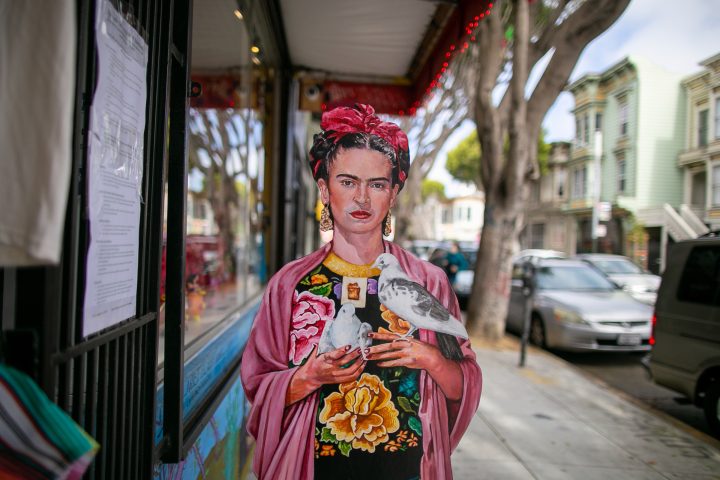
In 2019, I visited the bustling Casa Azul, Frida Kahlo’s colorful home-turned-museum. As a cultural worker and frequent museum goer, I was excited to enter this shrine for Kahlo lovers. As a full-blooded Purépecha woman, however, I felt out of place. La Casa Azul immediately stood out to me as the epitome of Mexican racial politics. Beyond the large contingent of foreign tourists, the Mexican audience was nothing like me: They were light-skinned, urbane, and uncritically fascinated by Kahlo. I left Casa Azul feeling disappointed and disenfranchised. While Kahlo wore rebozos like all the women in my family do, she still did not look like us. Missing from the public discourse about the artist are discussions about how the “nationalism” that Kahlo promoted both in her art and personal style perpetuate the construction of a mythologized Indianness at the expense of Indigenous people.
One of the most influential ideologies of 20th-century Mexican cultural consciousness was indigenismo, aptly summed as “the browning of the nation” by historian May Kay Vaughan. This term refers to a cultural ideology formulated by the Mexican white and mestizo (Spanish and Indigenous mixed race) elite that became official policy starting in the 1920s. It became so by both creating a new prototypical Mexican Indian and homogenizing the many distinct Indigenous cultures. In practice the term meant glorifying a redefined past fabricated by co-opting and simplifying Indigenous cultures to render them palatable to a mestizo hegemony, while assimilating Indigenous people into a modern nation-state. Unsurprisingly, Indigenous people were denied an active role in the conception and execution of this new ideology. It is through these historical conditions and cultural frameworks that Kahlo’s legacy needs reckoning.
Kahlo’s active participation in the construction of “Indianness” from the perspective of a mestizo dominant class can be seen in her adoption of Indigenous attire. While Kahlo frequently donned Tehuana dresses traditional to the isthmus of Tehuantepec, Kahlo had weak connections to the region, once stating in an interview for Excélsior: “I’ve never been to Tehuantepec, […] nor do I have any connection to the town, but of all Mexican dresses it’s the one I like the most, and that’s why I wear it.”
Kahlo, born to an affluent German father and mestiza mother (Spanish and Purépecha), adopted the popular fetishization and sanitization of the Tehuana favored by the cosmopolitan bourgeois, intellectual, and artistic circles of Mexico City. The appropriation of the Tehuana attire reflected how the grandeur of pre-Columbian civilizations might be made to conform to the tastes of a newly emerging national identity. Kahlo biographer Hayden Herrera further links this adoption to what has become the fashionable notion that Indigenous women are more earthbound and sensual.
For Kahlo the collection and display of pre-Hispanic artifacts and regional contemporary goods was another extension of her fetishization of Indigenous cultures. Photos of Kahlo posing with her and Diego Rivera’s collection of Indigenous goods nicely align Kahlo with indigenismo. Standing there is yet another means by which to recontextualize Indigenous cultures and make them a shared space in which virtually anyone may partake. As Professor Miriam Oesterreich has noted, the display and documentation of her private collection is not an appreciation of Indigenous cultures so much as it is an enhancement of Kahlo’s artistic status by highlighting the reference points of her brand. Such private collections furthered Kahlo’s accumulation of social capital and clout.
Kahlo’s aesthetic reflects the vogue of her time: the mythologizing of a homogenized Indigenous past afforded by her proximity to whiteness and wealth. While popular opinion touts Kahlo as going against the grain, she was, rather, very much partaking in the creation of a nationally-backed novel culture — a “true” Mexican indigeneity reconstructed as a mestizo and white ideation. Indigenous iconography found in her artwork are the result of her and artists like her rendering the cultures as up for grabs in the race to build a color-blind nation.
While Kahlo enjoyed the fame of her iconic attire, Indigenous people faced a different reality, one that forced our assimilation into “modern Mexico” while treating us as passive embodiments of a new national essence. Even left-leaning indigenista intellectuals agreed that Indigenous people were in need of intervention by the educated elite, since we were deemed incapable of participating in the creation of the nation’s future. In effect, indigenismo begat a paternalistic sentiment and the inferior status of Indigenous peoples by denying indigenous sovereignty and self-determination.
Indigenous people like me are left to reckon with contemporary idols like Kahlo who benefited from a digestible indigeneity and the myth of a monolithic Latinx culture within Mexico. Today, the most radical honoring of Indigenous peoples is letting us tell our own narratives. We have resisted threats to our existence and culture. We are still here. Listen when we speak.
Kahlo exists in a twilight zone of a mestizo hegemony at the expense Indigenous sovereignty. Her status and ability to wear “Indigenous” as an art practice substantially reflects her cultural role: a mestiza woman of the upper class. With sold-out exhibitions and record-breaking auction prices, Fridamania is not going away. Kahlo’s image and likeness will continue to be printed on everything from swap meet t-shirts to department store cosmetics. More nuanced discussions about the fraught nationalism to which she contributed, as well as the flattening of race, ethnicity, and nationality in Mexico are needed. While indigenismo was the creation of indigeneity without Indigenous voices, there are now opportunities to create a more inclusive dialogue about Kahlo by allowing Indigenous perspectives to reevaluate her legacy.
0 Commentaires